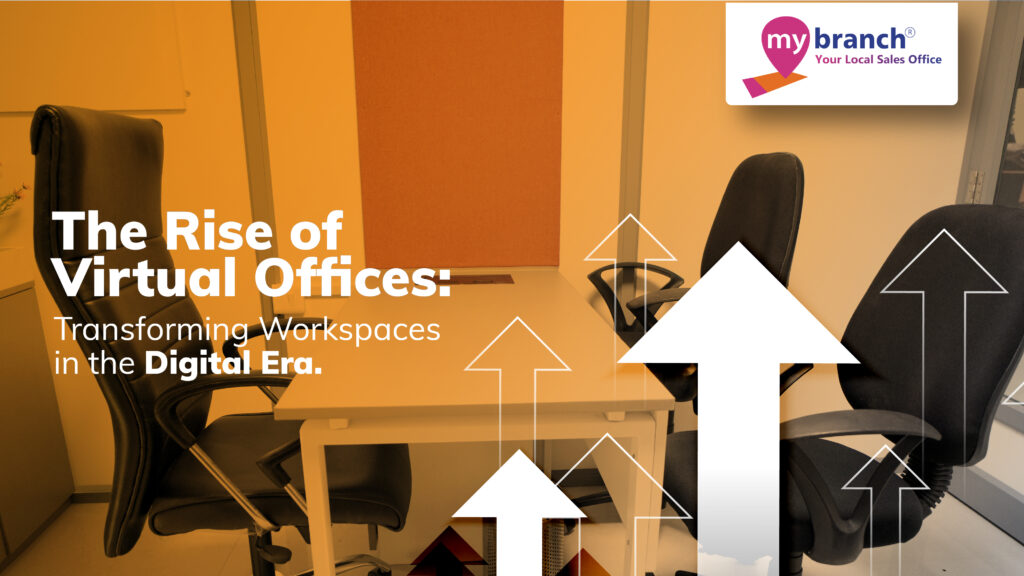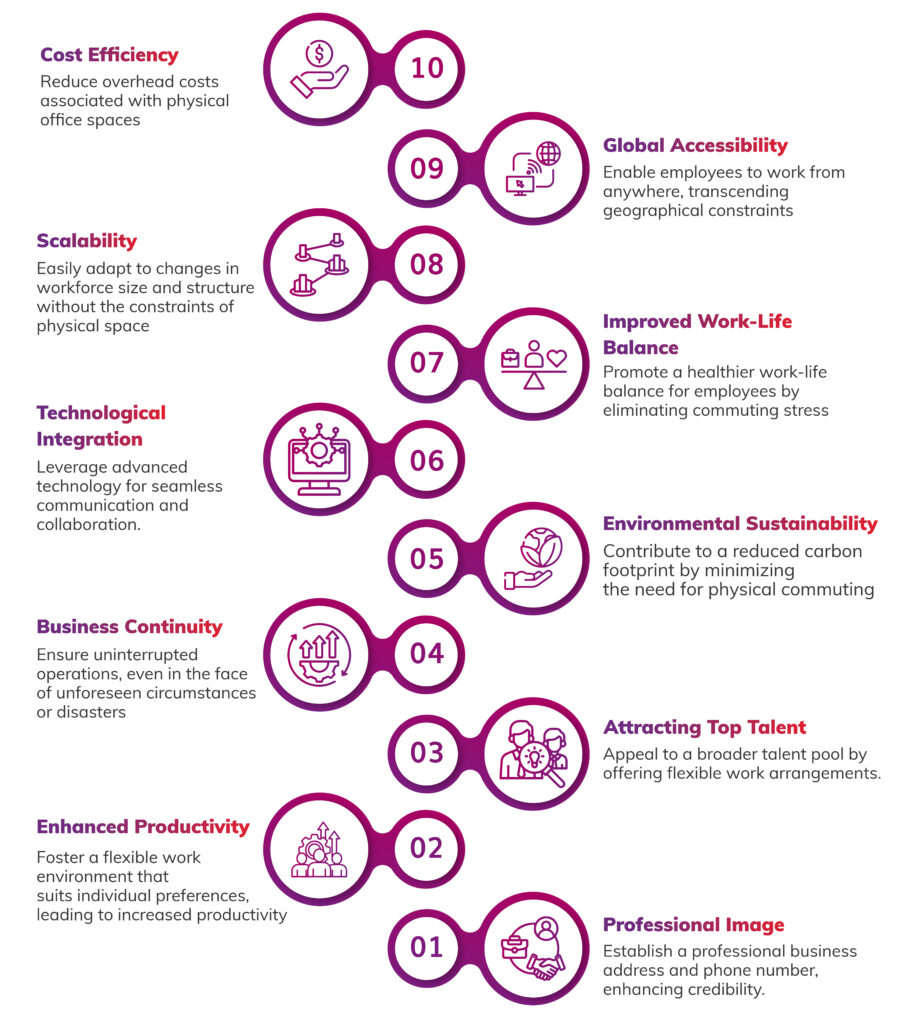
In the ever-evolving landscape of the business world, traditional office setups are gradually making way for innovative alternatives. One such trend that has gained significant traction in recent years is the rise of virtual offices. These virtual workspaces offer a flexible and dynamic solution to the changing needs of businesses in the digital age.
How to Utilize Virtual Office Space for Maximum Efficiency
Virtual offices provide businesses with the opportunity to redefine their approach to work. Unlike traditional offices, virtual office spaces operate in the digital realm, allowing employees to work from anywhere in the world. The key to harnessing the full potential of virtual office space lies in understanding how to utilize it for maximum efficiency.
One practical way to comprehend the purpose of a virtual office space is by breaking down its key components. According to Investopedia, a virtual office gives businesses access to essential services, such as a business address with GST registration, mail and package handling, phone services, meeting rooms, and video conferencing. These components collectively contribute to creating a seamless and interconnected virtual workspace.
Understanding the Purpose of Virtual Office Space
| Component | Purpose |
| Business Address | Establishes a professional presence without the need for a physical office |
| Mail and Package Handling | Ensures efficient management of correspondence and deliveries |
| Phone Services | Provides a dedicated business phone number, enhancing communication |
| Meeting Rooms | Facilitates virtual or on-demand meeting spaces, fostering collaboration |
Now that we have dissected the purpose of a virtual office space, it’s essential to explore why this trend is gaining momentum in the contemporary business landscape.
Why Is Virtual Office Space Becoming More Popular?
Virtual office spaces have gained popularity due to the rise of remote work, allowing individuals and teams to maintain a professional business presence without a physical office. The cost-effectiveness of virtual offices, with reduced overheads compared to traditional spaces, appeals to businesses seeking financial efficiency. As globalization and distributed teams become more prevalent, virtual offices enable companies to establish a presence in multiple locations. Technological advancements, especially in communication tools, have facilitated seamless collaboration for remote teams.
The flexibility offered by virtual offices, without long-term leases, suits the needs of startups and small businesses. Additionally, virtual offices provide a professional image, crucial for businesses operating remotely, while outsourcing administrative tasks contribute to a focus on core activities. The environmental considerations and sustainability aspects of reducing commuting and physical office space further contribute to the appeal of virtual office solutions. The COVID-19 pandemic accelerated the adoption of virtual offices as a practical solution for maintaining business operations during crises and lockdowns.
10 Reasons to Invest in Virtual Office Space: A List Form Perspective

The Role of Technology in Shaping Virtual Workspaces
As we delve deeper into the realm of virtual offices, it’s crucial to acknowledge the pivotal role that technology plays in shaping and sustaining these digital workspaces. The integration of advanced communication tools, project management software, and collaborative platforms has been instrumental in enabling seamless virtual collaboration.
- Communication and Collaboration Tools: The cornerstone of virtual workspaces lies in the plethora of communication and collaboration tools available. Platforms like Slack, Microsoft Teams, and Zoom have revolutionized how teams interact, fostering seamless communication regardless of geographical distances. Real-time messaging, video conferencing, and collaborative document editing have become integral components of the virtual work experience.
- Cloud Computing: Cloud technology has liberated work from physical servers and rigid infrastructures. Virtual workspaces leverage cloud computing for storage, allowing teams to access, share, and collaborate on documents in real-time. This flexibility not only enhances efficiency but also ensures that information is accessible from anywhere, promoting remote work.
- Project Management Software: Virtual workspaces often rely on project management tools such as Asana, Trello, and Jira. These tools enable teams to organize tasks, set deadlines, and track progress collaboratively. As a result, project timelines are streamlined, and teams can work cohesively, even if members are dispersed across different locations.
- Virtual Reality (VR) and Augmented Reality (AR): The integration of VR and AR technologies is redefining virtual workspaces by providing immersive experiences. Virtual meetings, training sessions, and collaborative projects can occur in virtual environments, fostering a sense of presence and connectivity among remote team members.
- Cybersecurity Measures: As virtual workspaces rely heavily on digital interactions, ensuring the security of sensitive data is paramount. Technology plays a crucial role in implementing robust cybersecurity measures, including encryption, multi-factor authentication, and secure VPNs, safeguarding virtual work environments from potential threats.
- Automation and Artificial Intelligence (AI): Automation and AI technologies streamline repetitive tasks, allowing employees to focus on more complex and creative aspects of their work. Chatbots, automated data analysis, and predictive algorithms enhance productivity within virtual workspaces, contributing to a more efficient and dynamic work environment.
- Mobile Accessibility: The ubiquity of smartphones and mobile applications has further facilitated virtual work. Mobile accessibility allows employees to stay connected and engaged, irrespective of their physical location. Virtual workspaces are no longer confined to desktops, providing flexibility and freedom to the workforce.
The integration of innovative technologies not only enhances productivity and collaboration but also shapes a new era of work that is defined by flexibility, connectivity, and efficiency. Embracing and adapting to these technological changes is crucial for businesses and individuals alike as they navigate the ever-evolving landscape of virtual workspaces.
Challenges and Solutions in Virtual Office Implementation
While the benefits of virtual offices are clear, their implementation is not without challenges.
- Communication Barriers:
Challenge: Virtual offices can face communication challenges due to the lack of face-to-face interactions, leading to misunderstandings and a potential breakdown in team cohesion.
Solution: Implement robust communication tools, schedule regular video conferences, and encourage open communication to bridge the gap and foster a sense of connection among team members.
2. Security Concerns:
Challenge: Virtual offices are vulnerable to cybersecurity threats, including data breaches and unauthorized access, as employees work from various locations.
Solution: Implement strong cybersecurity measures, use secure communication channels, conduct regular security training for employees, and ensure the use of secure, encrypted connections.
3. Team Collaboration:
Challenge: Collaboration may be hindered in a virtual environment, impacting the ability of teams to work seamlessly together on projects.
Solution: Utilize project management and collaboration tools, establish clear workflows, and encourage virtual team-building activities to enhance collaboration and maintain a sense of teamwork.
4. Employee Engagement and Motivation:
Challenge: Employees working in virtual offices may experience isolation, leading to decreased engagement and motivation.
Solution: Foster a positive company culture through virtual social events, recognize and reward achievements, and provide opportunities for professional development to keep employees engaged and motivated.
5. Technology Issues:
Challenge: Technical glitches, software compatibility issues, or inadequate technology infrastructure can disrupt virtual office operations.
Solution: Invest in reliable and up-to-date technology, provide technical support, and conduct regular training sessions to ensure that employees are proficient in using the tools required for virtual work.
6.Monitoring and Productivity:
Challenge: Managers may find it challenging to monitor employee productivity in a virtual setting, leading to concerns about accountability.
Solution: Establish clear performance expectations, use productivity tracking tools judiciously, and focus on output rather than micromanaging, fostering a culture of trust and accountability.
7. Work-Life Balance:
Challenge: Virtual work can blur the boundaries between professional and personal life, impacting employees’ work-life balance.
Solution: Encourage employees to set clear work hours, take breaks, and create designated workspaces. Promote a healthy work-life balance by respecting non-working hours and encouraging time off.
8. Cultural and Time Zone Differences:
Challenge: Virtual teams often consist of members from diverse cultures and time zones, leading to challenges in scheduling and understanding cultural nuances.
Solution: Foster cultural sensitivity, establish flexible meeting schedules to accommodate different time zones, and use collaboration tools that facilitate asynchronous communication when necessary.
MyBranch: A Prominent Player in the Virtual Office Space
Amidst the evolving landscape of virtual offices, Mybranch stands out as a prominent player, especially in tier 2 and tier 3 cities across India. Mybranch has strategically positioned itself as a leading provider of virtual office solutions, offering businesses a comprehensive suite of services to enhance their virtual presence and operational efficiency.
With a network of virtual office spaces across diverse locations, Mybranch enables businesses to establish a professional address in key cities, irrespective of their physical presence. This not only enhances the credibility of businesses but also opens up avenues for expansion and collaboration in untapped markets.
Mybranch’s commitment to technological innovation aligns seamlessly with the needs of the modern workforce. The integration of cutting-edge communication tools and secure virtual infrastructure ensures that businesses using Mybranch’s virtual offices experience a smooth and collaborative workflow.
In addition to the core virtual office services, Mybranch goes above and beyond by providing tailored solutions to meet the unique requirements of businesses operating in tier 2 and tier 3 cities. This localized approach sets Mybranch apart, recognizing the diversity of business landscapes and cultures across different regions.
The rise of virtual offices marks a transformative shift in the way businesses operate, adapting to the demands of the digital era. As traditional office spaces give way to innovative virtual solutions, the advantages are becoming increasingly evident. Understanding the purpose of virtual offices, their popularity, and the role of technology in shaping them is essential for businesses aiming to thrive in this dynamic landscape.
Virtual offices offer a myriad of benefits, from cost efficiency and global accessibility to enhanced productivity and environmental sustainability. The integration of advanced technologies, including communication tools, cloud computing, and virtual reality, plays a pivotal role in creating efficient and connected virtual workspaces.
Despite the numerous advantages, implementing virtual offices is not without challenges. Communication barriers, security concerns, and issues related to team collaboration and employee engagement require thoughtful solutions. Addressing these challenges ensures a smooth transition to a virtual office environment, fostering a culture of trust, accountability, and collaboration.
Mybranch emerges as a prominent player in the virtual office space, particularly in tier 2 and tier 3 cities across India. With a commitment to technological innovation and a localized approach, Mybranch provides businesses with tailored solutions, enhancing their virtual presence and operational efficiency.
Looking ahead, the future of work appears to be navigating towards a hybrid model that combines remote work and traditional office setups. Striking the right balance between flexibility and in-person collaboration will be crucial for businesses to succeed in this evolving landscape. As we embrace this new era of work, businesses must establish clear policies, invest in supportive technologies, and foster a culture that adapts to the diverse needs and preferences of the workforce.
In conclusion, the rise of virtual offices represents not just a trend but a fundamental shift in the way we define and engage with workspaces. Embracing virtual offices is not merely a response to current challenges; it is a strategic move towards a more agile, efficient, and connected future of work.
